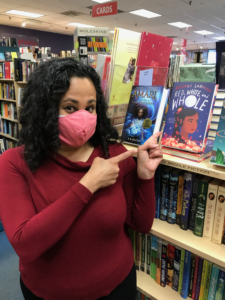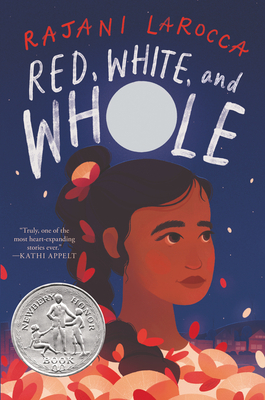As someone who doesn’t write novels-in-verse, I’m in awe of authors who tell stories using this lyrical form. In my previous post that analyzes Marilyn Hilton’s Full Cicada Moon, I explored how these types of novels draw a more immediate emotional response through their poetic techniques. In her gorgeous new novel-in-verse Red, White, and Whole, Rajani LaRocca also uses poetic techniques to great effect. There’s so much I could explore, but I want to look at one technique she uses that I found to be particularly breathtaking–her use of a refrain (or repetition).
The primary purpose of a refrain, or a recurring line throughout a poetic work (or prose for that matter), is to draw attention to something important. Used effectively, it can heighten the emotional resonance of your story and make it feel more universal, and LaRocca uses hers to great effect. Once a reader is watching for it, they will naturally pause and take note. LaRocca’s refrain reinforces her main character Reha’s feeling of being torn between two worlds.
NOTE: this post has MAJOR SPOILERS. If you haven’t already read Red, White, and Whole, please do so before you continue with this post. It’s beautiful and full of heart, and you will love it.
Setting Up the Refrain: Torn Between Two Cultures

At the beginning of Red, White, and Whole, Reha “feels torn between two worlds: school, where she’s the only Indian American student, and home, with her family and their community” (flap copy).Though she is very close to her parents, she does find at times that her desire to “do American things” (pg 69) clashes with the life her parents want her to live.
The refrain that LaRocca introduces is simple: I have two lives. As the first line of the book, it already has gravitas. Later, when the reader realizes it’s a refrain, they will pay even closer attention.
Here is the first and last stanza of the novel’s first poem.
Two
I have two lives.
One that is Indian,
One that is not.
I have two best friends.
One who is Indian,
One who is not.….
In both places I have
gossip and laughter
music and silence
friendship.
But only in one place do I have
my parents. (1)
For this first section of the book, LaRocca offers up a nonlinear set of beautiful and poignant poems that explore the differences in Reha’s two worlds. We learn gorgeous details about the customs, food, languages, and tales that ground her within the culture of her Indian parents. At the same time, we see Reha at school with her American friends, wanting “to chew gum, / wear cheap earrings, tight jeans, short skirts, / roller-skate holding hands.” (3) She just wants to have fun and fit in.
No doubt, anyone who is a second-generation child, either in America or elsewhere, will relate deeply to Reha’s complicated emotions. And for other readers, it’s a window that helps them to better empathize with what it’s like to be torn between two cultures.
However, at the midpoint, everything changes. Reha’s Amma (her mother) is diagnosed with a form of Leukemia. Now Reha joins a new club–children of parents in the hospital with cancer. She must navigate life with her mom at the hospital while still attempting to exist outside of that space, doing mundane things such as going to school, cooking dinner, and attending holiday celebrations.
Second Use of Refrain: Torn by Illness
Here’s where readers discover that “I have two lives” is a refrain. It draws attention to the important idea that humans can and often do have their lives torn apart by many things.
In this section, there’s a new poem also named “Two.” Here are its first seven lines:
I have two lives.
One in the hospital,
one outside.
One where Amma is,
one where she used to be.
One where people walk and talk and work and go to school,
and one where they are fighting for their lives, (119)
Same refrain, same repetitive line: “I have two lives.” But different. Anyone who is a child, either in America or elsewhere, who has gone through a parent having a terrible disease can relate deeply to the fear, sorrow, guilt and frustration Reha feels as she struggles with having her world torn apart in this new and unexpected way. She deals with things like watching her mom be tired all the time, her loss of hair, her having good days and bad days, her going into remission but only temporarily.
Reha is now in two intersecting clubs. She’s a child of immigrants and a child of a parent with cancer. That means that she deals with some very specific things that another child might not. For instance, her mom’s sister, Reha’s Prema Auntie, can’t get a visa to visit. They have to get the doctor to write a letter to the American embassy that explains that Amma is gravely ill. Those words haunt Reha.
Gravely ill.
I cannot get the words out of my head.
I want Prema Auntie to visit,
But I wish it weren’t for this reason. (129)
Those of us who are reading Red, White, and Whole as a window into another life experience, gain new insights into what additional hurdles immigrant families might face when confronted with an illness of this magnitude.
Tragically, Reha’s mother dies, which sadly means that Reha joins yet another club.
Third Use of Refrain: Torn by Death
LaRocca uses her refrain again, but there’s one very distinct difference. Instead of calling this new poem Two, she names it Jealous. As one might imagine, Reha is in a very dark place. Notice how she defines her own two lives with time and also contrasts herself with others. Here is an excerpt:
I have two lives.
The one Before
and the one After.
And I am jealous of the whole world.
I see Sunny,
Rachel,
Pete,
strangers on the street,
and burn with envy
because they have mothers,
and I don’t. (193)
This poem continues, dwelling on Reha’s anger, the unfairness of what happened, all the things Reha and her Amma will never experience together. It’s a powerful moment given even more of a spotlight through LaRocca’s use of her refrain.
For those who are members of this club, it will resonate deeply. For others, it can’t help but elicit strong empathy. In this section, we also see the intersection of Reha’s immigrant experience. We learn about what will happen with Amma’s ashes, that one day, they will be spread in a holy place in India.
This is the last time that this exact refrain is used. As Reha works through her grief, she is surprised by a letter her Amma wrote before she died. It communicates that her mom understood how torn Reha felt by straddling her two cultures. Through her heartfelt letter, Amma helps Reha to feel seen and ensures that she knows how deeply she is loved. This letter leads to Reha finding hope and starting down the road to healing.
New but Recognizable Refrain

Red, White, and Whole ends on a hopeful note with a new, albeit recognizable, refrain: “I have one life.” (208) The final poem demonstrates just how far Reha has come in her understanding of who she is and how the different facets of her life intersect and blend. Notice how she includes culture, place, relationships, and time. Here is one of its stanzas:
I have one life,
where I try to merge all the places I’m from,
India and America,
Mother and father,
Past, present, and future. (209)
There’s something quite special about the final poem’s structure. I’ve already pointed out that LaRocca used the original refrain three times, in three different poems, to emphasize three very particular turning points in Reha’s journey. Likewise, she uses this new refrain three times. However, with the new refrain, it’s used in three different stanzas in one final poem. This new refrain is insisting on replacing the old refrain, once and for all. For me, it drives home that Reha has truly grown in her understanding of herself in the complicated world she inhabits.
Now It’s Your Turn
Whether you write in prose or in verse, think about whether there are opportunities for a refrain in your own work–either a static reminder of something important or one that twists and turns with your main character’s life journey while relating its emotional truth. And don’t feel limited. There are other forms/devices that can recur to draw attention to what’s most important.
- Check your major turning points for whether you’ve already set yourself up for a refrain. You may only need a few minor tweaks to take advantage of this device.
- Play. Experiment. Brainstorm. Refrains should be fun.
- Consider whether your refrain will be static–a reminder of something important–or whether you will be twisting it to reinforce turning points.
- As an alternative, think about an endowed object as a refrain. (Keep an eye out for an upcoming post on endowed objects.)
- Another possible refrain might be the recurrence of an evocative smell or sound.
You may also enjoy reading about how Gary D. Schmidt uses repetition in Orbiting Jupiter to elicit emotion:
Kristi Wright (co-editor) writes picture books and middle grade novels. Her goal as a writer is to give children a sense of wonder, a hopefulness about humanity, and a belief in their future. She is represented by Kurestin Armada at Root Literary. She is an active volunteer for SCBWI and a 12 X 12 member. Find her at www.kristiwrightauthor.com and on Twitter @KristiWrite.


LOVED this analysis, Kristi. Brilliant and informative. Thank you!
Thank you! Wonderful points and very helpful, Kristi!
Thanks so much, Linda! It was such an interesting topic to explore! Warmly, Kristi